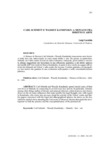Mostrar o rexistro simple do ítem
Carl Schmitt e Wassily Kandinsky: a Monaco fra diritto e arte
| dc.contributor.author | Garofalo, Luigi | |
| dc.date.accessioned | 2011-07-12T10:26:42Z | |
| dc.date.available | 2011-07-12T10:26:42Z | |
| dc.date.issued | 2009 | |
| dc.identifier.citation | Anuario da Facultade de Dereito da Universidade da Coruña, 2009, 13: 261-281. ISSN: 1138-039X | es_ES |
| dc.identifier.issn | 1138-039X | |
| dc.identifier.uri | http://hdl.handle.net/2183/7513 | |
| dc.description.abstract | [Abstract] Carl Schmitt and Wassily Kandinsky spend crucial years of their own lives in Munich, by connecting in several ways law and art. In particular, Schmitt, among other things author of literary and musical criticism, satirical pieces and stories, draws on the art many influences that make prolific his legal thought; and, with regard to Kandinsky, who wrote also an essay about the activity of the Volost’ courts and furt- her papers concerned with the legal and ethnographical spheres, he draws on the law, which he studied when attending the University of Moscow, themes that guide his deve- lopment in both the practice and the conceptualization of the pictorial art. | es_ES |
| dc.language.iso | ita | es_ES |
| dc.publisher | Universidade da Coruña | es_ES |
| dc.subject | Carl Schmitt | es_ES |
| dc.subject | Wassily Kandinsky | es_ES |
| dc.subject | Monaco | es_ES |
| dc.subject | Diritto | es_ES |
| dc.subject | Arte | es_ES |
| dc.subject | Munich | es_ES |
| dc.subject | Law | es_ES |
| dc.subject | Art | es_ES |
| dc.title | Carl Schmitt e Wassily Kandinsky: a Monaco fra diritto e arte | es_ES |
| dc.type | info:eu-repo/semantics/article | es_ES |
| dc.rights.access | info:eu-repo/semantics/openAccess |






